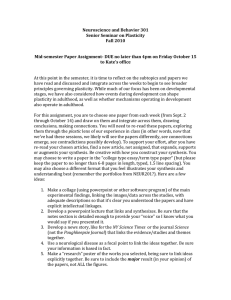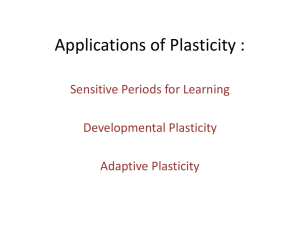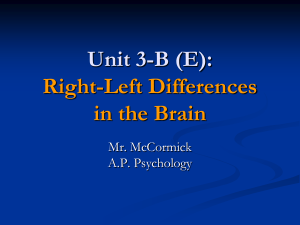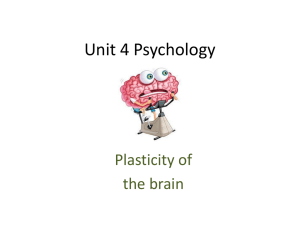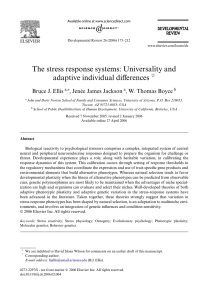Ecological consequences of phenotypic plasticity Benjamin G. Miner , Sonia E. Sultan
advertisement
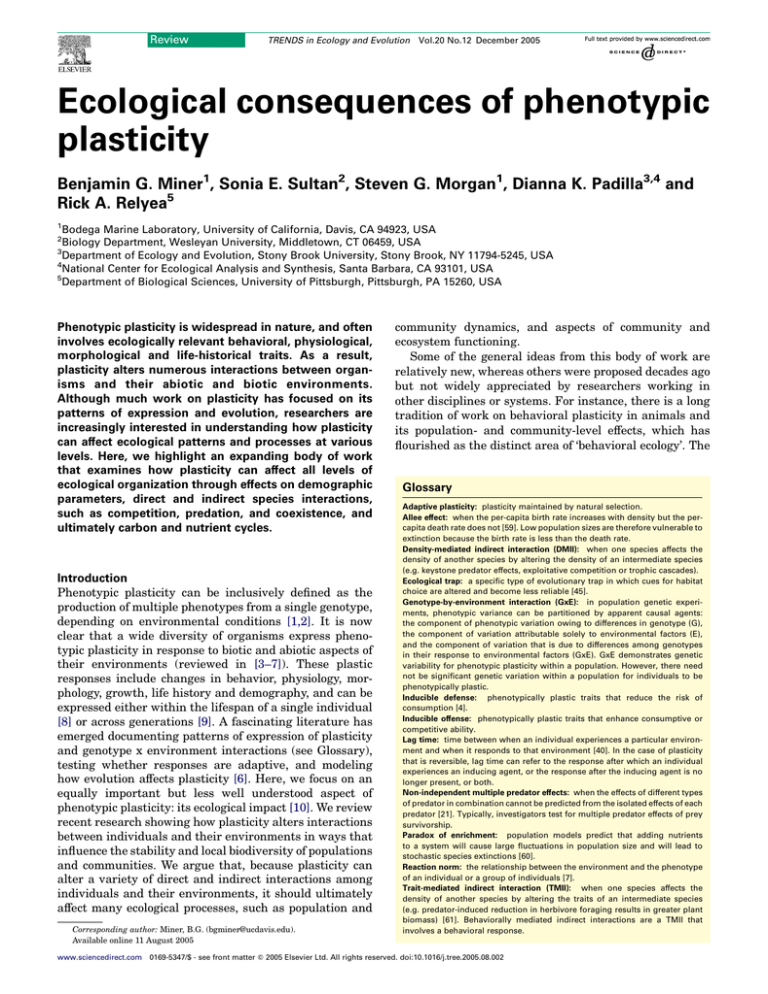
Review TRENDS in Ecology and Evolution Vol.20 No.12 December 2005 Ecological consequences of phenotypic plasticity Benjamin G. Miner1, Sonia E. Sultan2, Steven G. Morgan1, Dianna K. Padilla3,4 and Rick A. Relyea5 1 Bodega Marine Laboratory, University of California, Davis, CA 94923, USA Biology Department, Wesleyan University, Middletown, CT 06459, USA 3 Department of Ecology and Evolution, Stony Brook University, Stony Brook, NY 11794-5245, USA 4 National Center for Ecological Analysis and Synthesis, Santa Barbara, CA 93101, USA 5 Department of Biological Sciences, University of Pittsburgh, Pittsburgh, PA 15260, USA 2 Phenotypic plasticity is widespread in nature, and often involves ecologically relevant behavioral, physiological, morphological and life-historical traits. As a result, plasticity alters numerous interactions between organisms and their abiotic and biotic environments. Although much work on plasticity has focused on its patterns of expression and evolution, researchers are increasingly interested in understanding how plasticity can affect ecological patterns and processes at various levels. Here, we highlight an expanding body of work that examines how plasticity can affect all levels of ecological organization through effects on demographic parameters, direct and indirect species interactions, such as competition, predation, and coexistence, and ultimately carbon and nutrient cycles. Introduction Phenotypic plasticity can be inclusively defined as the production of multiple phenotypes from a single genotype, depending on environmental conditions [1,2]. It is now clear that a wide diversity of organisms express phenotypic plasticity in response to biotic and abiotic aspects of their environments (reviewed in [3–7]). These plastic responses include changes in behavior, physiology, morphology, growth, life history and demography, and can be expressed either within the lifespan of a single individual [8] or across generations [9]. A fascinating literature has emerged documenting patterns of expression of plasticity and genotype x environment interactions (see Glossary), testing whether responses are adaptive, and modeling how evolution affects plasticity [6]. Here, we focus on an equally important but less well understood aspect of phenotypic plasticity: its ecological impact [10]. We review recent research showing how plasticity alters interactions between individuals and their environments in ways that influence the stability and local biodiversity of populations and communities. We argue that, because plasticity can alter a variety of direct and indirect interactions among individuals and their environments, it should ultimately affect many ecological processes, such as population and Corresponding author: Miner, B.G. (bgminer@ucdavis.edu). Available online 11 August 2005 community dynamics, and aspects of community and ecosystem functioning. Some of the general ideas from this body of work are relatively new, whereas others were proposed decades ago but not widely appreciated by researchers working in other disciplines or systems. For instance, there is a long tradition of work on behavioral plasticity in animals and its population- and community-level effects, which has flourished as the distinct area of ‘behavioral ecology’. The Glossary Adaptive plasticity: plasticity maintained by natural selection. Allee effect: when the per-capita birth rate increases with density but the percapita death rate does not [59]. Low population sizes are therefore vulnerable to extinction because the birth rate is less than the death rate. Density-mediated indirect interaction (DMII): when one species affects the density of another species by altering the density of an intermediate species (e.g. keystone predator effects, exploitative competition or trophic cascades). Ecological trap: a specific type of evolutionary trap in which cues for habitat choice are altered and become less reliable [45]. Genotype-by-environment interaction (GxE): in population genetic experiments, phenotypic variance can be partitioned by apparent causal agents: the component of phenotypic variation owing to differences in genotype (G), the component of variation attributable solely to environmental factors (E), and the component of variation that is due to differences among genotypes in their response to environmental factors (GxE). GxE demonstrates genetic variability for phenotypic plasticity within a population. However, there need not be significant genetic variation within a population for individuals to be phenotypically plastic. Inducible defense: phenotypically plastic traits that reduce the risk of consumption [4]. Inducible offense: phenotypically plastic traits that enhance consumptive or competitive ability. Lag time: time between when an individual experiences a particular environment and when it responds to that environment [40]. In the case of plasticity that is reversible, lag time can refer to the response after which an individual experiences an inducing agent, or the response after the inducing agent is no longer present, or both. Non-independent multiple predator effects: when the effects of different types of predator in combination cannot be predicted from the isolated effects of each predator [21]. Typically, investigators test for multiple predator effects of prey survivorship. Paradox of enrichment: population models predict that adding nutrients to a system will cause large fluctuations in population size and will lead to stochastic species extinctions [60]. Reaction norm: the relationship between the environment and the phenotype of an individual or a group of individuals [7]. Trait-mediated indirect interaction (TMII): when one species affects the density of another species by altering the traits of an intermediate species (e.g. predator-induced reduction in herbivore foraging results in greater plant biomass) [61]. Behaviorally mediated indirect interactions are a TMII that involves a behavioral response. www.sciencedirect.com 0169-5347/$ - see front matter Q 2005 Elsevier Ltd. All rights reserved. doi:10.1016/j.tree.2005.08.002 686 Review TRENDS in Ecology and Evolution general framework for plasticity that we propose will make clear common principles that are relevant to diverse taxa as well as other types of phenotypic plasticity. For example, behavioral plasticity in animals and developmental plasticity in plants can have analogous effects on population stability and trophic interactions. Hence, our goal is to direct attention to the common ecological issues and questions that arise from an awareness of phenotypic plasticity as a general biological phenomenon. The effect of plasticity on individual–environment interactions Direct interactions The recognition that plasticity can be adaptive has stimulated a wealth of studies on how plasticity alters interactions between individual organisms and their environments [3–6]. Although this research program has been motivated largely by evolutionary questions, studies of adaptive plasticity such as inducible defenses and inducible offenses [4,10,11] (Box 1) also have clear ecological implications. For example, in East Africa, herbivory by elephants and giraffes induces longer and more numerous protective spines on Acacia drepanolobium trees [8], which enhances the survivorship and competitive ability of A. drepanolobium when subsequent herbivores arrive. Studies examining how plasticity affects the interactions of organisms with their environments typically focus on (i) an abiotic or biotic environmental factor (e.g. temperature or predation); and (ii) an ecologically relevant aspect of a phenotypic response to that factor. The altered phenotypes, in turn, affect subsequent interactions. For example, barnacles exposed to greater water velocities produce shorter feeding appendages [12], which affect food acquisition. Similarly, plants alter the growth and structure of roots in response to different concentrations of nutrients, which maximizes nutrient foraging in patchy soils [13]. This response increases the capture of essential nutrients, such as phosphate and, in turn, affects competitive interactions among plant species [13]. Many studies have shown that plasticity affects direct interactions between individuals and their biotic (e.g. predation, herbivory and competition) and abiotic (e.g. temperature and light) environments in a variety of ways and in a wide range of taxa [3–7]. Indirect interactions Recently, investigators have begun to consider how plasticity affects indirect interactions in multi-species assemblages. Before a decade ago, ecologists interested in indirect interactions were primarily concerned with the indirect effects of consumption [14]. A predator decreases the density of its prey, which in turn alters the strength of the interaction between the prey and a third species. Consequently, the predator, by consuming prey, indirectly affects the third species, typically referred to as a densitymediated indirect interaction. For example, predatory dragonfly larvae, through their consumption of frog tadpoles, indirectly interact with periphyton communities [15]. When dragonfly larvae are present, they consume www.sciencedirect.com Vol.20 No.12 December 2005 Box 1. Phenotypic plasticity in frog larvae Frog tadpoles are an effective system for exploring the ecology of phenotypic plasticity. Frequently, predators induce tadpoles to reduce their foraging activity, which reduces detection by predators [62]. Predators also induce relatively larger tails and smaller bodies in tadpoles (Figure I) [62], which reduce capture by predators [63] owing to faster swimming abilities and because a large tail lures predator strikes away from the vulnerable body [64]. However, both defenses come at the cost of slower growth [65], because predatorinduced tadpoles have smaller mouthparts [66] and shorter, less efficient intestines, and spend less time foraging [67]. Predators are only part of the story. Competitors induce the opposite suite of traits, enabling faster growth but at the cost of increased vulnerability to predation [66,67]. Tadpoles can fine-tune their phenotypes to different combinations of predator and competitor densities and balance these opposing inductive forces [68]. The existence of two inductive processes (i.e. changes in predator and competitor densities) means that predators can induce phenotypes directly as well as indirectly by consuming tadpoles and reducing competition among tadpoles. The direct effect of predators scaring tadpoles is primarily responsible for changes in tadpole morphology, whereas the direct and indirect effects of predators are equally responsible for changes in tadpole behavior [69]. These responses are induced by chemical cues, and tadpoles can discriminate among predator species, exhibiting predator-specific phenotypes. This suggests that different predators emit unique chemicals [70]. Tadpoles can also discriminate among different diets for a given predator, suggesting that diet mediates these chemical signals [71]. Furthermore, the magnitude of defense induced by a predator consuming different diets is inversely related to the phylogenetic distance between tadpoles and the diet of that predator, which includes other species of tadpoles, insects and snails [72]. Because amphibians live in a heterogeneous landscape of predation and competition, plastic traits are favored owing to a tradeoff between predator resistance and growth. This tradeoff affects not only individuals, but also the community via trait-mediated indirect effects [16], and is one example of why amphibians are an excellent model system to use to study the ecology of phenotypic plasticity. Figure I. Morphological plasticity in tadpoles. Tadpole (a) has been exposed to predators, resulting in the induction of a colorful and relatively large tail. Tadpole (b) has not been exposed to predators and has a less colorful and relatively small tail. Reproduced with permission from Rick Relyea. tadpoles, thereby reducing tadpole density, which decreases the grazing pressure of tadpoles on the algae. Plasticity can also generate indirect interactions, typically referred to as trait-mediated indirect interactions. For example, in addition to eating tadpoles, dragonfly larvae also induce tadpoles to forage less, which causes an increase in algal densities [15]. Thus, Review TRENDS in Ecology and Evolution Vol.20 No.12 December 2005 687 Box 2. Multiple predator effects Multiple predators can also affect survivorship of prey across life histories. In an East African rainforest, the frog Hyperolius spinigularis lays its developing embryos on leaves that overhang ponds, and hatchlings drop into the pond and develop as tadpoles until metamorphosis [23]. While on the leaves, the presence of another frog Afrixalus fornasini, which preys on the embryos of H. springularis, induces them to hatch early and at a small size (i.e. life-history plasticity). Once in the pond, tadpoles are exposed to predatory larvae of the libellulid dragonfly Trapezostigma basilaris. Although the two predators do not interact directly, they interact indirectly through the prey. Thus, the presence of the arboreal predator reduced the effectiveness of the aquatic predator by 70% compared with the predicted survivorship from each predator in isolation (Figure Ia). This reduction in risk is caused equally by plasticity and density effects (Figure Ib). Studies of predator–prey interactions generally consider only a single type of predator, yet, prey are commonly threatened by more than one type of predator in nature. More than half of the empirical studies reviewed by Sih et al. [21] demonstrated multiple predator effects, whereby inclusion of additional types or species of predators altered (i.e. enhanced or reduced) the predation risk for the prey species. For example, two freshwater predators (sculpin Cottus bairdi and stonefly larvae Agnetina capitata) consume mayfly Baetis tricaudatus larvae. When both sculpin and stonefly larvae are present, each consumes fewer mayflies than when each predator is alone [73] (i.e. the presence of a predator weakens the strength of the interaction between the other type of predator and prey). This is because sculpin induce stonefly larvae to hide beneath rocks and reduce their foraging activity [74]. Thus, plasticity leads to risk reduction. (a) (b) No predators No. surviving 20 Larval predator only 10 8 Egg predator only 6 Both (observed) 4 % Aquatic-stage survival 40 C 100 90 80 70 BC B B 60 50 40 A 30 Both (expected) 2 Absent Present Aquatic predator 20 Egg predator: Aquatic predator: None Density Size/Age Present Density + size/age None Absent Figure I. Multiple predator effect across life-history stages. (a) The survivorship of frog Hyperolius spinigularis embryos on exposure to four combinations of predators. Circles represent the absence of the egg predator, and squares represent the presence of the egg predator. (b) The survivorship of prey when the effects of density and plasticity are isolated. Letters indicate significant differences among treatments. Reproduced, with permission, from [23]. dragonfly larvae also indirectly interact with algae by altering the behavior of the tadpoles. This area of research is rapidly increasing (recently reviewed in [16–19]), and demonstrates that plasticity, by altering indirect interactions, can influence the strength of competition [20], facilitation [21] and trophic cascades [22], as well as cause non-independent multiple predator effects [23] (Box 2). To date, most research on indirect interactions via plasticity has examined anti-predator behavior. However, morphological plasticity can also cause indirect interactions [24], and it is likely that any type of plasticity can alter the direction and strength of indirect interactions. Although most research has focused on plastic responses to biotic conditions, plastic responses to abiotic factors can also result in indirect effects. For example, plants might respond phenotypically to predicted atmospheric change. Plants respond to elevated CO2 through changes in leaf chemistry, which reduce tissue nutritional quality for herbivores. This affects herbivore feeding behavior, development time and predation risk [25], leading to larger effects on community dynamics [26]. Niche construction Many organisms have the ability to modify the environments that they experience, called ‘niche construction’ www.sciencedirect.com [27]. Recently, work has demonstrated that plasticity can result in niche construction [28], and it is especially interesting when environmental modifications lead to improvements [28]. For example, in response to shading by neighboring plants, many plants elongate shoot internodes to overtop these competitors, a developmental response that brings the photosynthetic organs of that individual into a more favorable light environment [29]. In Arabidopsis thaliana, shading by neighbors also induces a change in phenology by accelerating reproductive onset [29]. This plastic response enhances the resource environment of the plant during the crucial period of seed and fruit maturation, because, in most habitats, light as well as nutrient availability decline later in the growth season [29]. Niche constructions can also create feedbacks that shape subsequent interactions between the individual and its environment. For example, A. thaliana disperses seeds at different spatial scales depending on the density of conspecifics. Thus, the current density of conspecifics affects the future density of conspecifics through plasticity in dispersal, and thus alters subsequent dispersal [28]. The research on plasticity influencing niche construction has primarily focused on plants and the effects of morphological and life-history plasticity [28,29]. This research demonstrates that individual–environment Review TRENDS in Ecology and Evolution interactions might be more complex than was previously thought. Altered interactions have consequences for populations and communities Population stability and species co-existence The idea that behavioral and physiological plasticity can affect population dynamics was suggested O20 years ago (reviewed in [3,30]). However, there is an increasing interest in the effects of plasticity on population dynamics, and early ideas are being re-discovered or investigated for different types of plasticity. For example, a variety of inducible defenses and offenses can affect the amplitude of population fluctuations, and increase the stability of a population within a community with two or three trophic levels [31–38]. Plasticity can stabilize a population because plastic responses are often density dependent. In a simple predator–prey system, the size of the prey population initially increases followed by an increase in the size of the predator population. The increase in the predator population induces prey defenses, which can reduce the population growth rate of the prey. The increase in prey defenses also slows the size increase of the predator population because prey are now better defended, slowing per-capita consumption rates. The opposite is true when population sizes decrease. Thus, the phenotypic response of a prey to predator density results in a negative feedback that can stabilize the population size of both predator and prey [35]. In a similar manner, phenotypic responses of a predator to prey can also stabilize population sizes [39]. The ability of plasticity to stabilize a population is strongly dependent on the lag between the induction time of a plastic response and the timing of environmental changes [32,39,40]. As the lag time increases, the ability of plasticity to stabilize a population decreases, increasing the amplitude of population fluctuations [32,39,40]. Interestingly, the ability of inducible defenses to stabilize a population can explain the absence of the paradox of enrichment, and might resolve the discrepancy between theoretical and empirical studies [36,37] (Box 3). Given that plasticity can affect the stability of populations, it is not surprising that plasticity can also affect species coexistence within communities. Recent theoretical work suggests that adaptive plasticity, both inducible offenses and defenses, can increase species permanence by enlarging the conditions in which species can coexist [36,37,41–43]. For example, with a mathematical model, Krivan [43] demonstrated that a community with a top predator, two consumer species, and a resource species was more likely to persist when the predator had adaptive behavioral plasticity and could switch its prey preference to maximize its growth, compared with when the predator had a fixed behavior. For the stability and permanence of species, whether plasticity is adaptive probably has a large effect. This is because longer lag times of plasticity can destabilize populations, and increase the likelihood that plasticity will be non-adaptive [40]. However, if the response is adaptive, then the type of plasticity (e.g. behavioral, morphological, or physiological) might have relatively www.sciencedirect.com Vol.20 No.12 December 2005 Box 3. The paradox of enrichment Population models predict that adding nutrients to a system will cause large fluctuations in population size and lead to stochastic species extinctions. This is referred to as the ‘paradox of enrichment’. However, populations are often more stable when nutrients are added to natural systems than models predict [36,37,75]; a possible explanation for this is plasticity. In theoretical models, inducible defenses can stabilize population fluctuations, reducing the probably that populations will go extinct and, thus, eliminating the paradox of enrichment [36,37,75]. In an empirical test of the predictions of theoretical models, Verschoor et al. found similar results in experiments with aquatic organisms [37]. They demonstrated that population fluctuations were much less in a system with an alga, herbivorous zooplankton, and carnivorous zooplankton when the species of alga had an inducible defense than when it did not (Figure I). (a) (i) Undefended algae (ii) (iii) 100 10 1 0.1 0.01 0.001 (b) (i) Plankton biomass (mg Cl–1) 688 (ii) (iii) 100 10 1 0.1 0.01 0.001 0 5 10 15 20 25 0 † 5 10 15 20 25 0 5 10 15 20 25 Inducible-defended algae (c) (i) (ii) (iii) (ii) (iii) 100 10 1 0.1 0.01 0.001 (d) (i) 100 10 1 0.1 0.01 0.001 0 5 10 15 20 25 0 5 10 15 20 25 0 5 10 15 20 25 Time (d) Figure I. Inducible defenses lead to the absence of the paradox of enrichment. The symbols indicate algae (filled circles), herbivorous zooplankton (open circles) and carnivorous zooplankton (filled triangles). (a) and (b) represent experiments with an undefended alga, whereas (c) and (d) represent experiments with an alga with inducible defenses. (a) and (c) represent an experiment with two trophic levels, and (b) and (d) represent one with three trophic levels. (i–iii) indicate the replicate. Reproduced, with permission, from [37]. little effect because selection should favor short lag times for any type of plasticity. Although it is typically assumed that morphological plasticity has longer lag times compared with more immediate types of responses, such as behavioral plasticity, lag times are a product of the time it takes to induce a particular phenotype and the timing Review TRENDS in Ecology and Evolution Box 4. Ecological realism in plasticity experiments Controlled experiments are required to document precisely plastic responses to specific environmental variables. However, the results of such studies are ecologically meaningful only if experimental conditions match salient aspects of natural environmental variation. Plasticity studies explicitly recognize that the researcher’s choice of environmental manipulations can profoundly influence experimental results. Hence, the key to designing ecologically informative plasticity experiments is to recreate the kind of environmental variation that elicits plastic responses in the natural setting of the organism; in other words, careful attention to ecological realism. Identifying environmental factors that cue plasticity Identifying the precise cue or cues that induce a plastic response can be challenging. For instance, submerged tadpoles might sense imminent pond drying through changes in temperature or chemical concentration, visual effects of surface proximity, or increased swim contact to induce accelerated metamorphosis [76]. Moreover, plasticity cues can consist of specific aspects of environmental variables, such as the spectral quality of shade treatments [77]. Recognizing these specific factors is crucial because their correlations with particular ecological pressures can vary from one habitat or site to another, shaping the expression and evolution of plasticity in distinct populations [78]. In some cases, a known proximal cue can be experimentally separated from its natural context, enabling a plastic response to be tested in alternative ecologically relevant environments [79]. Implementing appropriate treatments Ecologically meaningful data also demand realistically designed levels of relevant environmental factors, ideally based on naturally occurring states. Arbitrary treatment levels (e.g. stressful versus favorable) can produce ecologically misleading results for two reasons. First, because the relationship between phenotypic responses and environmental variation is often nonlinear [80], responses to arbitrary treatments cannot be simply extrapolated to field conditions. Second, variance among genotypes, populations or taxa will depend upon the environmental states studied [81]. The timing and pattern of applying experimental treatments is also important [82]. In some cases, it is important to alter the variance, range or frequency of environmental states rather than the mean [83]. This information requires careful, repeated measurements of field conditions, but can provide a useful interpretive context for ecological and evolutionary questions [54,80]. Accounting for real-world complexity Perhaps the most important (and most difficult) step in creating ecologically realistic plasticity experiments is to incorporate the realworld complexity of multiple biotic and abiotic variables. The ecological impact of any plastic response depends on the functional and fitness tradeoffs that it creates in the context of these environmental demands. Although controlled experiments can incorporate several interacting factors, it is only through field experiments that the ability of the organism to integrate all of its environmental demands through plasticity can be tested. Field studies can also identify interacting environmental factors (e.g. local consumers or competitors), suggest additional plastic traits that merit study, and reveal specific life-cycle stages at which various plastic traits are most ecologically important and therefore should be measured. In this way, results of field experiments can be invaluable in shaping the controlled studies needed to characterize precisely specific aspects of plasticity, as well as in testing their functional and fitness consequences. and rate of environmental change. It is therefore possible that a quick behavioral response can result in a longer lag time than can a slow morphological response, and there is currently no evidence that responses that can occur more quickly have shorter lag times. Studies of behavioral and morphological plasticity [36,37,41–43], as well as www.sciencedirect.com Vol.20 No.12 December 2005 689 plasticity that affects of niche construction [44], demonstrate that plasticity can promote stability, species coexistence or both. However, any type of plasticity has the potential to promote stability and species coexistence as long as there is an appropriate density-dependent response. Ecological and evolutionary traps Plastic responses are often induced by environmental cues. However, these have the potential to become less reliable (e.g. as a result of anthropogenic effects) and negatively affect populations. When this happens, it is referred to as an evolutionary trap [45]. For example, mayflies use polarized light, which indicates the presence of water, as a cue for where to lay their eggs. However, dry asphalt and black plastic used to cover agricultural fields also reflect polarized light, and mayflies have been observed laying their eggs on roads or plastic sheets [46]. Although evolutionary traps can arise whenever an organism that is plastic uses a cue that becomes less reliable, negative effects are likely to be larger when cues for neutral or adaptive plasticity are altered, because what were beneficial or neutral responses are now detrimental responses. Given that many species have adaptive inducible defenses and offenses to other species, invasive species might be a common and important cause of evolutionary traps [47]. Ecological traps, which are a specific type of evolutionary trap, can also lead to allee effects that increase the probability of a population going extinct [48]. Take the situation in which a cue for habitat choice is altered so that individuals now prefer low-quality sites. When populations are large, individuals can compete for preferred sites but ones of a low quality, which can lead to individuals occupying sites that are less preferred but higher quality [48]. However, when a population is small, individuals only occupy preferred, low-quality sites; thus, population growth is reduced because a greater proportion of the population occupies low-quality sites. Local biodiversity Recently, studies have demonstrated that plasticity can affect local biodiversity by altering indirect interactions [49–51]. For example, in a New England field, the presence of spiders increases local biodiversity because spiders induce several species of herbivores to seek refuge in and graze on a competitively dominant plant species, which enables competitively inferior plant species to increase [49]. Thus, by altering indirect effects, behavioral plasticity can affect biodiversity. However, it remains to be seen whether plasticity can alter biodiversity in other ways [49–51]. In addition, the effects of plasticity might have important ecological consequences on the health and persistence of communities, because biodiversity can influence community and ecosystem functioning [52]. Future directions We have highlighted several ways in which plasticity can alter ecological patterns and processes at the level of individuals, populations and complex communities. However, it remains to be seen whether these higher-level 690 Review TRENDS in Ecology and Evolution effects of individual plasticity are widespread in natural systems. Several aspects of plasticity deserve attention because they influence the direction and the strength of individual–environment interactions, and are, consequently, likely to alter the ecological impact of plasticity. These include: (i) time lags between environmental cues and plastic responses [4,40]; (ii) reversibility of response [53]; and (iii) the shape of reaction norms with respect to environmental gradients [6,7]. An important contribution will be made by studies of plasticity that focus explicitly on these factors to consider general principles for understanding plasticity in its ecological context. At present, studies on various types of plasticity (i.e. behavioral, physiological, morphological or life historical) are generally considered separately. Yet, it is unclear whether the ecological consequences of different types of plasticity will differ. For example, behavioral, physiological and morphological plasticity can all stabilize populations. We need a better understanding of whether different types of plasticity have similar ecological effects, which will require not only further research, but also well designed experiments (Box 4) and better communication among researchers. Most plasticity research focuses on putatively adaptive responses to environmental challenges, such as inducible defenses and offenses. However, it is equally important to investigate the ecological consequences of non-adaptive environmental responses [10,54], which are likely to be common [55,56]. This is especially true for maladaptive plasticity that should amplify the effects of environmental change through the negative effects on individuals. For example, the snail Physella virgata flees and produces a more rotund shell when in the presence of certain non-molluscivorous sunfish that pose no risk. This maladaptive response slows the growth of individuals and is likely to alter population and community dynamics [55]. The consequences of plasticity for whole-community structure and dynamics, and ecosystem processes remain largely unknown. Nonetheless, plasticity is likely to have important effects, including the transfer of energy, numbers of trophic levels, and habitat interactions and feedbacks. Carbon cycles, nutrient cycles and primary productivity are likely to be altered by plastic effects on growth and morphology of ‘ecosystem engineers’ and other keystone species, as well as more subtle effects on community composition [57]. For example, induced behavioral responses in organisms, such as diel vertical migrations [4], will affect the transport and cycling of carbon and nutrients in aquatic systems. A more complex case is posed by feedbacks between nutrient availability and inducible defenses in terrestrial plants and marine algae: in these situations, carbon and nutrient availability affects the expression of inducible defenses, which in turn alter carbon and nitrogen balance through interspecific effects [58]. Exciting new avenues for research include the effects of plasticity on community diversity, resilience, zonation and patchiness, as well as rates of energy transfer throughout ecosystems and ecosystem functioning [52]. www.sciencedirect.com Vol.20 No.12 December 2005 Conclusions Interest in the ecological consequences of plasticity is increasing. By adopting an inclusive definition for the term ‘phenotypic plasticity’, we hope that researchers will recognize the broad implications of their work for a diversity of taxa and biological disciplines. Studies of plasticity in its ecological context provide a rich opportunity for interdisciplinary collaborations, to reveal not only patterns and mechanisms of environmental response, but also the direct and indirect effects of those responses on the relationship of organisms to their abiotic and biotic environments and, consequently on higher-level ecological processes. Acknowledgements This article is a product of a symposium at the 2004 annual meeting of the Ecological Society of America. We thank all the symposium participants and co-organizers, and reviewers. This work was funded by a National Science Foundation grant (OCE 0325028) awarded to S.G.M. and B.G.M. and was conducted while D.K.P. was a Sabbatical Fellow at the National Center for Ecological Analysis and Synthesis, a Center funded by NSF (Grant #DEB-0072909), the University of California, and the Santa Barbara campus. Contribution number 2252 Bodega Marine Laboratory, University of California, Davis. References 1 Bradshaw, A.D. (1965) Evolutionary significance of phenotypic plasticity in plants. Adv. Genet. 13, 115–155 2 Sultan, S.E. and Stearns, S.C. Environmentally contingent variation: phenotypic plasticity and norms of reaction. In Variation: A Central Concept in Biology (Hall, B. and Hallgrimsson, B., eds), Elsevier Academic Press (in press) 3 Karban, R. and Baldwin, I.T., eds (1997) Induced Responses to Herbivory, University of Chicago Press 4 Tollrain, R. and Harvell, C.D., eds (1999) The Ecology and Evolution of Inducible Defenses, Princeton University Press 5 Sultan, S.E. (2000) Phenotypic plasticity for plant development, function and life history. Trends Plant Sci. 5, 537–542 6 Pigliucci, M. (2001) Phenotypic Plasticity: Beyond Nature and Nurture, Johns Hopkins University Press 7 DeWitt, T.J. and Scheiner, S.M., eds (2004) Phenotypic Plasticity: Functional and Conceptual Approaches, Oxford University Press 8 Young, T.P. et al. (2003) Effects of natural and simulated herbivory on spine lengths of Acacia drepanolobium in Kenya. Oikos 101, 171–179 9 Agrawal, A.A. et al. (1999) Transgenerational induction of defences in plants and animals. Nature 401, 60–63 10 Schmitz, O.J. et al. (2003) Linking individual-scale trait plasticity to community dynamics. Ecology 84, 1081–1082 11 Karban, R. and Agrawal, A.A. (2002) Herbivore offense. Annu. Rev. Ecol. Syst. 33, 641–664 12 Marchinko, K.B. (2003) Dramatic phenotypic plasticity in barnacle legs (Balanus glandula Darwin): magnitude, age dependence, and speed of response. Evolution 57, 1281–1290 13 Hodge, A. (2004) The plastic plant: root responses to heterogeneous supplies of nutrients. New Phytol. 162, 9–24 14 Wootton, J.T. (1994) The nature and consequences of indirect effects. Annu. Rev. Ecol. Syst. 25, 443–446 15 Peacor, S.D. and Werner, E.E. (2001) The contribution of traitmediated indirect effects to the net effects of a predator. Proc. Natl. Acad. Sci. U. S. A. 98, 3904–3908 16 Werner, E. and Peacor, S.D. (2003) A review of trait-mediated indirect interactions in ecological communities. Ecology 84, 1083–1100 17 Peacor, S.D. and Werner, E. (2004) How dependent are species-pair interaction strengths on other species in the food web? Ecology 85, 2754–2763 18 Schmitz et al. (2004) Trophic cascades: the primacy of trait-mediated indirect interactions. Ecol. Lett. 7, 153–163 19 Preissier, E.L. et al. (2005) Scared to death? The effects of intimidation and consumption in predator–prey interactions. Ecology 86, 501–509 Review TRENDS in Ecology and Evolution 20 Relyea, R.A. (2000) Trait-mediated indirect effects in larval anurans: reversing competition with the threat of predation. Ecology 81, 2278–2289 21 Sih, A. et al. (1998) Emergent impacts of multiple predators on prey. Trends Ecol. Evol. 13, 350–355 22 Trussell, G.C. et al. (2002) Field evidence of trait-mediated indirect interactions in a rocky intertidal food web. Ecol. Lett. 5, 241–245 23 Vonesh, J.R. and Osenberg, C.W. (2003) Multi-predator effects across life-history stages: non-additivity of egg- and larval-stage predation in an African treefrog. Ecol. Lett. 6, 503–508 24 Raimondi, P.T. et al. (2000) Processes structuring communities: evidence for trait-mediated indirect effects through induced polymorphisms. Oikos 91, 353–361 25 Stiling, P. et al. (2003) Elevated CO2 lowers relative and absolute herbivore density across all species of a scrub-oak forest. Oecologia 134, 82–87 26 Korner, C. (2000) Biosphere responses to CO2 enrichment. Ecol. Appl. 10, 1590–1619 27 Odling-Smee, F.J. et al. (1996) Niche construction. Am. Nat. 147, 641–648 28 Donohue, K. (2005) Niche construction through phenological plasticity: life history dynamics and ecological consequences. New Phytol. 166, 83–92 29 Donohue, K. (2003) Setting the stage: plasticity as habitat selection. Int. J. Plant Sci. 164, S79–S92 30 Rosenzweig, M.L. and MacArthur, R.H. (1963) Graphical representation and stability condition of predator–prey interactions. Am. Nat. 97, 209–223 31 De Roos, A.M. et al. (1992) Studying the dynamics of structured population models: a versatile technique and its application to Daphnia. Am. Nat. 139, 123–147 32 Underwood, N. (1999) The influence of plant and herbivore characteristics on the interaction between induced resistance and herbivore population dynamics. Am. Nat. 153, 282–294 33 Luttbeg, B. and Schmitz, O.J. (2000) Predator and prey models with flexible individual behavior and imperfect information. Am. Nat. 155, 669–683 34 Bolker, B. et al. (2003) Connecting theoretical and empirical studies of trait-mediated interactions. Ecology 84, 1101–1114 35 Ramos-Jiliberto, R. (2003) Population dynamics of prey exhibiting inducible defenses: the role of associated costs and density-dependence. Theor. Popul. Biol. 64, 221–231 36 Vos, M. et al. (2004) Inducible defences and the paradox of enrichment. Oikos 105, 471–480 37 Verschoor, A.M. et al. (2004) Inducible defences prevent strong population fluctuations in bi- and tri-trophic food chains. Ecol Lett. 7, 1143–1148 38 Rinaldi, S. et al. (2004) Remarks on antipredator behavior and food chain dynamics. Theor. Popul. Biol. 66, 277–286 39 Abrams, P.A. and Matsuda, H. (2004) Consequences of behavioral dynamics for the population dynamics of predator–prey systems with switching. Popul. Ecol. 46, 13–25 40 Padilla, D.K. and Adolph, S.D. (1996) Plastic inducible morphologies are not always adaptive: the importance of time delays in a stochastic environment. Evol. Ecol. 10, 105–117 41 Persson, L. and De Roos, A. (2003) Adaptive habitat use in sizestructured populations: linking individual behavior to population processes. Ecology 84, 1129–1139 42 Krivan, V. and Diehl, S. (2005) Adaptive omnivory and species coexistence in tri-trophic food webs. Theor. Popul. Biol. 67, 85–99 43 Krivan, V. (2003) Competitive co-existence caused by adaptive predators. Evol. Ecol. Res. 5, 1163–1182 44 Hui, C. et al. (2004) Metapopulation dynamics and distribution, and environmental heterogeneity induced by niche construction. Ecol. Model. 177, 107–118 45 Schlaepfer, M.A. et al. (2002) Ecology and evolutionary traps. Trends Ecol. Evol. 17, 474–480 46 Kriska, G. et al. (1998) Why do mayflies lay their eggs en masse on dry asphalt roads? Water-imitating polarized light reflected from asphalt attracts Ephemeroptera. J. Exp. Biol. 201, 2273–2286 47 Schlaepfer, M.A. et al. (2005) Introduced species as evolutionary traps. Ecol. Lett. 8, 241–246 www.sciencedirect.com Vol.20 No.12 December 2005 691 48 Kokko, H. and Sutherland, W.L. (2001) Ecological traps in changing environments: ecological and evolutionary consequences of a behaviorally mediated Allee effect. Evol. Ecol. Res. 3, 537–551 49 Schmitz, O.J. (2003) Top predator control of plant biodiversity and productivity in an old-field ecosystem. Ecol. Lett. 6, 156–163 50 Duffy, E.J. et al. (2005) Ecosystem consequences of diversity depend on food chain length in estuarine vegetation. Ecol. Lett. 8, 301–309 51 Mouritsen, K.N. and Poulin, R. (2005) Parasites boosts biodiversity and changes animal community structure by trait-mediated indirect effects. Oikos 108, 344–350 52 Hooper, D.U. et al. (2005) Effects of biodiversity on ecosystem functioning: a consensus of current knowledge. Ecol. Monogr. 75, 3–35 53 Piersma, T. and Drent, J. (2003) Phenotypic flexibility and the evolution of organismal design. Trends Ecol. Evol. 18, 228–233 54 Sultan, S.E. (2003) Commentary: the promise of ecological developmental biology. J. Exp. Biol. 296B, 1–7 55 Langerhans, R.B. and DeWitt, T.J. (2002) Plasticity constrained: overgeneralized induction cues cause maladaptive phenotypes. Evol. Ecol. Res. 4, 857–870 56 Sih, A. et al. (2004) Behavioral syndromes: an ecological and evolutionary overview. Trends Ecol. Evol. 19, 372–378 57 Callaway, R.M. et al. (2003) Phenotypic plasticity and interactions among plants. Ecology 84, 1115–1128 58 Peckol, P. et al. (1996) Interactive effects of inducible defense and resource availability on phlorotannins in the North Atlantic brown alga Fucus vesiculosus. Mar. Ecol. Progr. Ser. 138, 209–217 59 Alee, W.C. (1931) Animal Aggregations. A Study in General Sociology, University of Chicago Press 60 Rosenzweig, M.L. (1971) Paradox of enrichment: destabilization of exploitation ecosystem in ecological time. Science 171, 385–387 61 Abrams, P.A. (1995) Implications of dynamically variable traits for identifying, classifying, and measuring direct and indirect effects in ecology communities. Am. Nat. 146, 112–134 62 Van Buskirk, J. and McCollum, S.A. (2000) Functional mechanisms of an inducible defence in tadpoles: morphology and behavior influence mortality risk from predation. J. Evol. Biol. 13, 336–347 63 Van Buskirk, J. and Relyea, R.A. (1998) Selection for phenotypic plasticity in Rana sylvatica tadpoles. Biol. J. Linn. Soc. 65, 301–328 64 Van Buskirk, J. et al. (2003) The lure effect, tadpole tail shape, and the target of dragonfly strikes. J. Herpetol. 37, 420–424 65 Van Buskirk, J. (2000) The costs of an inducible defense in anuran larvae. Ecology 81, 2813–2821 66 Relyea, R.A. and Auld, J.R. Predator- and competitor-induced plasticity: how changes in foraging morphology affect phenotypic trade-offs. Ecology (in press) 67 Relyea, R.A. and Auld, J.R. (2004) Having the guts to compete: how intestinal plasticity explains costs of inducible defenses. Ecol. Lett. 7, 869–875 68 Relyea, R.A. (2004) Fine-tuned phenotypes: tadpole plasticity under 16 combinations of predators and competitors. Ecology 85, 172–179 69 Relyea, R.A. (2002) The many faces of predation: how selection, induction, and thinning combine to alter prey phenotypes. Ecology 83, 1953–1964 70 Teplitsky, C. et al. (2004) Hierarchical responses of tadpoles to multiple predators. Ecology 85, 2888–2894 71 Summey, M.R. and Mathis, A. (1998) Alarm responses to chemical stimuli from damaged conspecifics by larval anurans: tests of three neotropical species. Herpetologica 54, 402–408 72 Schoeppner, N.M. and Relyea, R.A. (2005) Damage, digestion, and defense: the roles of alarm cues and kairomones for inducing prey defenses. Ecol. Lett. 8, 505–512 73 Soluk, D.A. (1993) Multiple predator effects: predicting combined functional response of stream fish and invertebrate predators. Ecology 74, 219–224 74 Soluk, D.A. and Collins, N.C. (1988) A mechanism for interference between stream predators: responses of the stonefly Agnetina capitata to the presence of scuplins. Oecologia 76, 630–632 75 Abrams, P.A. and Walters, C.J. (1996) Invulnerable prey and the paradox of enrichment. Ecology 77, 1125–1133 76 Denver, R.J. et al. (1998) Adaptive plasticity in amphibian metamorphosis: responses of Scaphiopus hammondii tadpoles to habitat desiccation. Ecology 79, 1859–1873 692 Review TRENDS in Ecology and Evolution 77 Griffith, T. and Sultan, S.E. (2005) Shade tolerance plasticity in response to neutral versus green shade cues in Polygonum species of contrasting ecological breadth. New Phytol. 166, 141–148 78 Galen, C. et al. (2004) An experimental test of the adaptive evolution of phototropins: blue-light photoreceptors controlling phototorpism in Arabidopsis thaliana. Evolution 58, 515–523 79 Schmitt, J. et al. (1999) Manipulative approaches to testing adaptive plasticity: phytochrome-mediated shade-avoidance responses in plants. Am. Nat. 154, S43–S54 Vol.20 No.12 December 2005 80 Scheiner, S.M. (1993) Genetics and evolution of phenotypic plasticity. Annu. Rev. Ecol. Syst. 24, 35–68 81 Lewontin, R.C. (1974) The analysis of variance and the analysis of causes. Am. J. Hum. Genet. 26, 400–411 82 Wayne, P.M. and Bazzaz, F.A. (1993) Birch seedling responses to daily time courses of light in experimental forest gaps and shadehouses. Ecology 74, 1500–1515 83 Miner, B.G. and Vonesh, J.R. (2004) Effects of fine grain environmental variability on morphological plasticity. Ecol. Lett. 7, 794–801 Forthcoming Conferences Are you organizing a conference, workshop or meeting that would be of interest to TREE readers? If so, please e-mail the details to us at TREE@elsevier.com and we will feature it in our Forthcoming Conference filler. 8–12 January 2006 Ecology in an Era of Globalization, Fiesta Americana Hotel, Merida, Yucatan, Mexico http://www.esa.org/mexico/ 12–13 January 2006 Wild rangelands: conservation in the world’s grazing ecosystems, Zoological Society of London, UK http://www.zoo.cam.ac.uk/ioz/meetings.htm 23–24 March 2006 Trade-offs in conservation: deciding what to save, Zoological Society of London, UK http://www.zoo.cam.ac.uk/ioz/meetings.htm 23–27June 2006 Annual meeting of the Society for the Study of Evolution, State University of New York at Stony Brook, USA http://lsvl.la.asu.edu/evolution/symp06.html 24–29 June 2006 Society for Conservation Biology, San Jose, CA, USA http://conbio.org/2006/ 11–12 July 2006 BES/IEEM Ecological Impact Assessments: Science and Best Practice, Bath Spa University College, Bath, UK http://www.britishecologicalsociety.org/articles/groups/conservation/bes_ieem_conf/ 23–29 July 2006 11th International Behavioral Ecology Congress, Tours, France. http://www.isbe2006.com/ 6–11 August 2006 91st ESA Annual Meeting, Memphis, TN, USA http://www.esa.org/memphis/ 13–19 August 2006 24th International Ornithological Congress, Hamburg, Germany http://www.i-o-c.org 22–26 August 2006 1st European Congress of Conservation Biology, Eger, Hungary http://www.eccb2006.org/ 5–7 September 2006 British Ecological Society Annual Meeting, University of Oxford, Oxford, UK http://www.britishecologicalsociety.org/ www.sciencedirect.com
